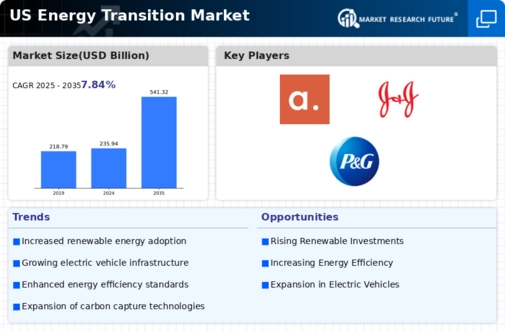Public Awareness and Advocacy
Public awareness and advocacy for climate change and sustainable energy practices are playing a crucial role in the energy transition market. Grassroots movements and non-profit organizations are actively promoting the benefits of renewable energy and the need for policy changes to support clean energy initiatives. In 2025, public support for renewable energy has reached an all-time high, with surveys indicating that over 80% of Americans favor increased investment in clean energy technologies. This heightened awareness is pressuring policymakers to prioritize renewable energy projects and implement regulations that facilitate the transition. As public sentiment continues to shift towards sustainability, the energy transition market is likely to benefit from increased investment and support for innovative energy solutions.
Corporate Sustainability Goals
The energy transition market is increasingly influenced by corporate sustainability goals as businesses recognize the importance of environmental responsibility. Many corporations are setting ambitious targets to reduce greenhouse gas emissions, with some aiming for net-zero emissions by 2050. This trend is evident in sectors such as technology and manufacturing, where companies are investing in renewable energy sources to power their operations. For example, major tech firms have committed to sourcing 100% renewable energy for their data centers. This corporate shift not only drives demand for clean energy solutions but also fosters innovation within the energy transition market, as companies seek to develop and implement sustainable practices that align with their environmental objectives.
Consumer Demand for Sustainable Solutions
There is a notable shift in consumer preferences towards sustainable energy solutions, significantly impacting the energy transition market. A recent survey indicates that over 70% of consumers in the US are willing to pay a premium for renewable energy sources. This growing demand is prompting utilities and energy providers to invest in cleaner energy options, such as wind and solar. Furthermore, the rise of electric vehicles (EVs) is also influencing consumer behavior, with EV sales projected to reach 25% of total vehicle sales by 2030. This trend not only reflects a commitment to reducing carbon footprints but also drives innovation and investment in the energy transition market, as companies strive to meet the evolving expectations of environmentally conscious consumers.
Government Incentives and Financial Support
Government incentives and financial support mechanisms are pivotal in shaping the energy transition market. Federal and state-level initiatives, such as tax credits and grants for renewable energy projects, have catalyzed investments in clean energy technologies. For instance, the Investment Tax Credit (ITC) allows for a 26% tax credit for solar energy systems installed before 2026, significantly lowering the financial barrier for adoption. Additionally, the Biden administration's commitment to achieving a 100% clean energy economy by 2035 has led to increased funding for research and development in renewable technologies. These supportive policies not only stimulate market growth but also encourage private sector participation, thereby accelerating the transition towards a more sustainable energy landscape.
Technological Innovations in Energy Generation
The energy transition market is experiencing a surge in technological innovations that enhance energy generation efficiency. Breakthroughs in solar photovoltaic (PV) technology, such as bifacial panels and perovskite cells, are driving down costs and increasing energy output. In 2025, the average cost of solar energy has decreased by approximately 30% compared to 2020 levels, making it a more attractive option for consumers and businesses alike. Additionally, advancements in wind turbine design, including larger rotor diameters and improved materials, are contributing to higher energy yields. These innovations not only support the growth of renewable energy sources but also play a crucial role in the overall energy transition market, as they enable a more sustainable and resilient energy infrastructure.

















Leave a Comment